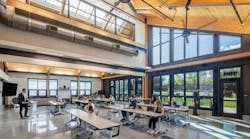8 Tips for Converting Remnant Buildings Into Schools
Faced with overcrowded schools and ever-shrinking capital budgets, more and more school districts are turning to the existing building stock for their next school expansion project.
Retail malls, big-box stores, warehouses, and even dingy old garages are being transformed into high-performance learning spaces, and at a fraction of the cost and time required to build classrooms from the ground up.
But, as leading industry experts will attest, these projects can be considerably more challenging than designing and building from scratch. “Conversions should not be viewed as the cheap way out,” says Michael E. Hall, AIA, director and chief marketing officer with K-12 school design specialist Fanning Howey, Celina, Ohio.
Technical experts consulted by BD+C offer eight valuable tips to ease the task of converting a nonschool building into a K-12 facility:
1. Don't skimp on the up-front building and site investigation.
All too often, school districts will commission the design team after the building and site are acquired, says Warren Gran, FAIA, partner with GranKriegel Architects & Planners, New York. That can be a mistake.
“Oftentimes, the client is pressed for time or simply doesn't want to pay for the up-front investigation work,” says Gran, whose firm has completed several K-12 conversions throughout New York City, including the recently opened Lighthouse Charter School in the Bronx, which incorporates a converted two-story garage. “School districts have to know exactly what they're getting because it can severely impact all aspects of the project, especially cost, schedule, and program.”
Gran urges clients to spend money up front to bring in subcontractors for nearly every major discipline—including site work, structural, and MEP—for a thorough investigation of the existing property.
2. Avoid low ceilings at all cost.
Nearly all conversion projects require complete replacement of the existing mechanical systems to meet the air quality and changeover requirements of school environments. Therefore, high ceilings are a must, says Hall.
Hall recommends that the existing building have enough floor-to-floor height to allow minimum nine-foot ceilings, plus several additional feet above the ceiling for mechanical ductwork, light fixtures, and technology distribution.
Big boxes and warehouse buildings typically provide more than enough clearance height for classrooms, but historical structures and strip malls may not.
Even with 12-foot floor-to-floor heights, squeezing the required systems in can be difficult, says Gran. His firm is currently designing two schools within the Brooklyn Family Courthouse, which has 12-foot height clearances. “We'll probably end up having to run most of the main mechanical distribution through vertical shafts,” he says. “It really impacts the flexibility of planning.”
3. Target structures that have adequate water and sewer service.
Plumbing infrastructure is one of the big-ticket items on school conversion projects, but Building Teams can save a bundle by finding a facility that is already equipped with adequate water and sewer service.
“Educational facilities have high water/sewer needs due to restroom requirements and food service,” says Hall. “Some codes may require a sprinkler system, depending on the room layout, so make sure the building can provide adequate pressure and flow, or that it can be easily upgraded.”
Big-box stores and strip malls may not have the infrastructure capacity for a school, but many industrial and warehouse facilities do.
That was the case at the Bathgate Educational Campus in the Bronx. The 140,000-sf, two-story building, which houses three discrete high schools with 500 students each under one roof, was constructed on the foundation of an industrial warehouse.
“Because of the capacity of the connections within the existing warehouse, we were able to reuse most of the infrastructure and connect right into the city sewer and sanitary system,” says Chuck Heaphy, senior project manager with John Ciardullo Associates, New York, design architect for the $52 million facility. “If we had to bring in all new plumbing connections, it certainly would have added to the cost and schedule.” Having water and sewer infrastructure in place also streamlined the permitting process with the city.
4. Test the structural capacity of the existing foundation.
For conversion projects that involve significant alterations to the existing structure, make sure to test the foundation for structural capacity using several core drillings throughout the floor slab. This advice applies in particular when adding a second story or installing concrete masonry unit (CMU) demising walls.
“Many retail environments are constructed with four-inch slabs with no reinforcement, so you many run into structural issues,” says Fanning Howey's Hall. Manufacturing and warehouse facilities, on the other hand, are typically constructed with six-inch, reinforced floor slabs that can easily carry a six-inch CMU wall that is 10-12 feet high, according to Hall.
Still, there's no guarantee that reinforced industrial warehouse floors are going to hold up. At Bathgate, extensive foundation reinforcement was required to support the load of a second story that was added to accommodate the 1,500 students.
“Each of the structure's 100 interior columns had one existing footing that was only able to handle 750 pounds per square foot, so we had to modify all the interior footings,” says Heaphy. The project involved digging out around each column, drilling four 40-ton steel piles into the bedrock, and then inserting a massive steel plate that acted as the connection between the piles and the existing columns.
To minimize costly reinforcement work around the exterior of the foundation, the Building Team replaced the heavy existing masonry wall with a lightweight metal-skin wall.
5. Make sure the existing structure can accommodate security measures.
The structure to be converted must allow for a design that provides a safe and secure environment with visual control of entry points, secured exits, adequate exterior lighting, and access to emergency services, says Hall.
Building location is also crucial when it comes to security. “Malls and downtown areas have excessive car and foot traffic,” says Hall. “This increases the potential for security breaches. It may require the separation of parking areas with fences.”
Hall also recommends the integration of large vestibules in the main entrance. “We've been designing these huge vestibules where the interior doors are locked and all visitors are required to go through the main office to get access to the school,” he says. “With all the security issues we have today, you have to be able to handle the mix of people around nontraditional school environments.”
6. Make the most of daylighting opportunities.
With school districts placing increased emphasis on creating high-performance learning and teaching spaces, daylighting schemes have become vitally important to school planning programs.
Transforming dark, dingy boxes into vibrant, light-filled environments requires extensive retrofitting. Warehouses and big-box stories generally require the most work because of their deep bays and minimal existing windows and skylights.
Typical daylighting schemes can include everything from adding punched windows and clerestories along the perimeter walls to constructing skylights and roof monitors within the core. “We've even had to cut through floors on multi-story projects to create light wells to get daylight into the interior classrooms,” says Hall. Hall says that daylighting schemes can get pricey, but quickly adds that “it's our job to convince the clients that they need to spend the money for important features like daylighting.”
Designers at architecture firm Perkins+Will had to do some convincing to get their extensive daylighting plan approved for the Academy @ 998 charter school in Buffalo, N.Y. The project, which involves converting an abandoned Kmart into a school for older, underachieving students in the Buffalo Public Schools, will incorporate clerestory and punched windows along the perimeter, skylights throughout the interior spaces, and a massive roof monitor at the core that will flood natural light into the facility's multipurpose/performance space.
The team is raising a portion of the roof to make way for the light-filled multipurpose space and adding 12-foot-high, all-glass demising walls between the classrooms and the circulation corridors.
“We saw this as a great opportunity to explore with daylighting,” says Peter Brown, K-12 education market sector leader and a principal in P+W's Dallas office. Brown says a major challenge was providing sufficient daylight and views given the structure's tight, urban site. “Most of the daylight will have to come from the roof, but we're also putting minimal window punches in the exterior walls to meet the classroom daylighting and view requirements for the state education bureau,” he says.
7. Check the roof for structural stability and thermal performance.
The roof should not only be adequate enough to support snow, rain, and wind loading required for educational occupancies, but also provide sufficient thermal and acoustic insulation for a learning environment.
Because most retail and industrial buildings are built to save on first costs, roof upgrades—everything from a complete re-roof to simple enhancements like spray-on insulation—are often required in conversions to schools. “If the roof is in good shape structurally, I'd recommend keeping it and dealing with thermal and acoustic insulation inside the building,” says Hall. “Measures like spray-on fiberglass insulation on the ceilings, carpet, CMU walls, and laminated glass can help insulate the interior spaces.”
For the Academy @ 998 conversion project, which is currently in the construction documents phase, P+W is planning to keep the roof structure, but will replace the existing roof deck with a lightweight system and a new “cool” roof. The new roof deck will also help control acoustics in the school, says P+W's Brown.
“The steel roof deck will have perforations and will be acoustically insulated,” says Brown. “Inside, the roof and all the mechanicals will be completely exposed.” Other acoustic measures include adding insulation to the existing CMU perimeter walls.
8. Know when to say no to conversions.
Fanning Howey's Hall says the rule of thumb in evaluating existing buildings for schools is that if the conversion is going to run more than two-thirds the cost of a new building, then you should strongly consider new construction. “The tradeoffs may be too great if the economic benefits are not there,” he says.
Hall says some districts use more-stringent benchmarks. New Mexico's school board, for instance, will not opt for conversion if the project does not save at least 50% over new construction.
However, Hall urges that it's not just about dollars and cents. “School districts can't take the attitude of 'We'll just put all these kids in a big warehouse and be done with it,'” he says. “The result should be something the kids are proud of.”

